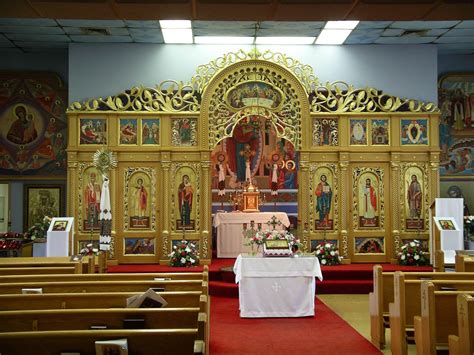I have already mentioned in the two “Altars and Alterations” posts that Patriarch Dwayhi (also spelt Doueihy and many variants) said that in his day (he died in 1704), the altars in Maronite churches stood before the cathedra, that is, the chair of the bishop (or the bishop’s delegate, the priest). This showed, he said, that Christ stood before God as our representative. We see some changes in the way liturgies were celebrated, and in the lay-out of the church, and the form of the altar. Yet, as Dix said in relation to the Mozarabic, Ambrosian, and other rites, they were seen as being not different things, but different ways of doing the same thing (The Shape of the Liturgy, 551)
I have also mentioned that the Orthodox tradition likewise had free-standing altars. This shows, once more, how the Maronites and Orthodox shared the same traditions in many respects. I also touched on how the theology of the Divine Liturgy was reflected in the architecture of the churches. Some books on ancient Christian worship concentrate on the terms of the liturgy, thus showing a Protestant bias, I suggest. The circumstances in which something is said can have quite an influence on how we understand what is said. Before I come to my conclusion, I should point out something of the history of the “high altar.”
The work of Gregory Dix has been superseded in many respects, but not so far as I know, in what he says about the altar, and he sees the high altar as a Western medieval development. In fact, the Western churches originally had cube altars, like those in Orthodox churches. Dix wrote that there was a “change in the shape of the Western altar from the antique fashion of a cube some 3 feet square to that of oblong altars 10, 12, or more feet long, in the new gothic churches.” (412) He wrote:
The first great change in Western ceremonial, the bringing of the celebrant round from behind the altar where he faced the people, to before it where he had his back to them, appears to have begun, almost accidentally, in Gaul and the Rhineland during the eighth-ninth century. It was due to certain architectural and devotional changes of fashion. The placing of bodies or relics of martyrs under the altar, in imitation of Revelation 6:9, goes back certainly to the fourth century, probably to pre-Nicene times. In Merovingian France, the usual Western desire to ‘see’ led to the relics being placed upon the altar in costly reliquaries, a cause of some inconvenience on the small square altars of the period. Ultimately they were placed on pedestals behind it, blocking the celebrant’s access to his old position.
His consequent coming round to the front involved certain changes of ceremonial. The bishop kept his throne, the symbol of his teaching office; but it was now placed on the gospel side between the altar and the people, to give him easy access to his new position, only going to the altar at the offertory.
The presbyter, having as such no teaching office, abandoned the use of the chair and began to conduct all that part of the synaxis which concerned him at the altar itself, only retiring to a seat on the epistle side to listen to such parts of the synaxis as formed the special ‘liturgy’ of the lesser ministers – the lections and chants. (591)
Dix also writes: “The placing of anything whatever upon the altar except the bread and the cup for the eucharist was entirely contrary to normal Christian feeling down to c. A.D. 800.” (412) However, he has a footnote to the effect that Narsai refers to a Cross upon the altar (n1, 412). Since Narsai died about 502, this is very early – but note that it is Eastern.
Dix goes on to note that in the ninth century in the West, certain items were being placed on the altar: the Gospel book, a pyx with the reserved sacrament, and reliquaries. (412) These are rather sacred items in themselves. But even then, Crosses and lamps would be hung above the altar, not upon it. Not until 1195 do we hear of an altar-cross between two candles. (412) This custom spread in the thirteenth and fourteenth centuries but was not found everywhere, in the Latin West, before the 16th century. Even then: “The Roman custom … during most of the Middle Ages was to remove these novel ornaments as soon as the liturgy was over, leaving the altar outside service-time as bare as it had always been in the past.” The earliest reference to a candle on an altar in England dates from 1180 or thereabout (419).
See also: http://www.fryuhanna.com/2017/07/18/of-altars-and-alterations-part-1/
